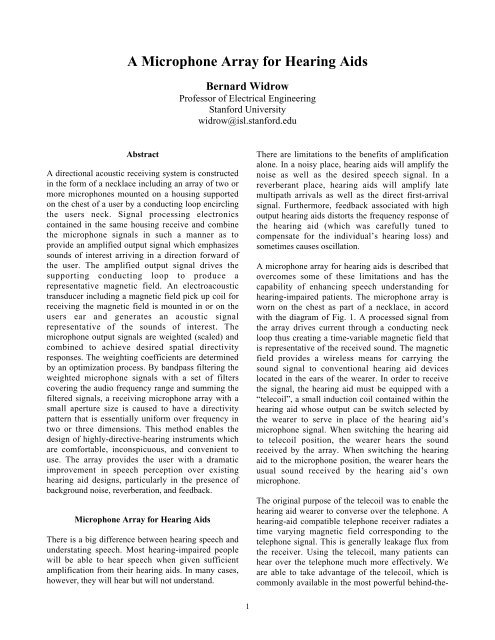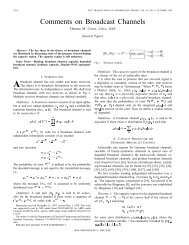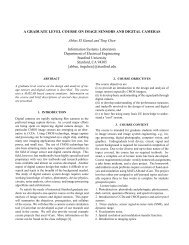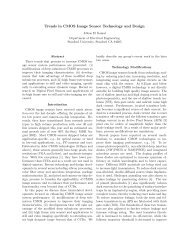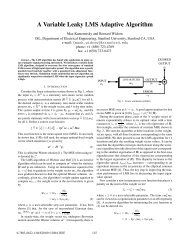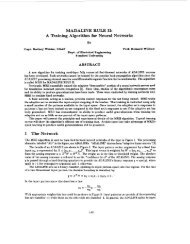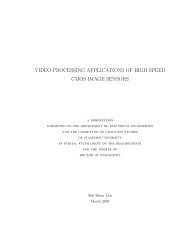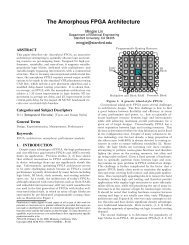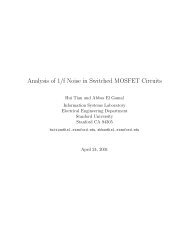A Microphone Array for Hearing Aids - Information Systems ...
A Microphone Array for Hearing Aids - Information Systems ...
A Microphone Array for Hearing Aids - Information Systems ...
You also want an ePaper? Increase the reach of your titles
YUMPU automatically turns print PDFs into web optimized ePapers that Google loves.
A <strong>Microphone</strong> <strong>Array</strong> <strong>for</strong> <strong>Hearing</strong> <strong>Aids</strong><br />
Bernard Widrow<br />
Professor of Electrical Engineering<br />
Stan<strong>for</strong>d University<br />
widrow@isl.stan<strong>for</strong>d.edu<br />
Abstract<br />
A directional acoustic receiving system is constructed<br />
in the <strong>for</strong>m of a necklace including an array of two or<br />
more microphones mounted on a housing supported<br />
on the chest of a user by a conducting loop encircling<br />
the users neck. Signal processing electronics<br />
contained in the same housing receive and combine<br />
the microphone signals in such a manner as to<br />
provide an amplified output signal which emphasizes<br />
sounds of interest arriving in a direction <strong>for</strong>ward of<br />
the user. The amplified output signal drives the<br />
supporting conducting loop to produce a<br />
representative magnetic field. An electroacoustic<br />
transducer including a magnetic field pick up coil <strong>for</strong><br />
receiving the magnetic field is mounted in or on the<br />
users ear and generates an acoustic signal<br />
representative of the sounds of interest. The<br />
microphone output signals are weighted (scaled) and<br />
combined to achieve desired spatial directivity<br />
responses. The weighting coefficients are determined<br />
by an optimization process. By bandpass filtering the<br />
weighted microphone signals with a set of filters<br />
covering the audio frequency range and summing the<br />
filtered signals, a receiving microphone array with a<br />
small aperture size is caused to have a directivity<br />
pattern that is essentially uni<strong>for</strong>m over frequency in<br />
two or three dimensions. This method enables the<br />
design of highly-directive-hearing instruments which<br />
are com<strong>for</strong>table, inconspicuous, and convenient to<br />
use. The array provides the user with a dramatic<br />
improvement in speech perception over existing<br />
hearing aid designs, particularly in the presence of<br />
background noise, reverberation, and feedback.<br />
<strong>Microphone</strong> <strong>Array</strong> <strong>for</strong> <strong>Hearing</strong> <strong>Aids</strong><br />
There is a big difference between hearing speech and<br />
understating speech. Most hearing-impaired people<br />
will be able to hear speech when given sufficient<br />
amplification from their hearing aids. In many cases,<br />
however, they will hear but will not understand.<br />
There are limitations to the benefits of amplification<br />
alone. In a noisy place, hearing aids will amplify the<br />
noise as well as the desired speech signal. In a<br />
reverberant place, hearing aids will amplify late<br />
multipath arrivals as well as the direct first-arrival<br />
signal. Furthermore, feedback associated with high<br />
output hearing aids distorts the frequency response of<br />
the hearing aid (which was carefully tuned to<br />
compensate <strong>for</strong> the individual’s hearing loss) and<br />
sometimes causes oscillation.<br />
A microphone array <strong>for</strong> hearing aids is described that<br />
overcomes some of these limitations and has the<br />
capability of enhancing speech understanding <strong>for</strong><br />
hearing-impaired patients. The microphone array is<br />
worn on the chest as part of a necklace, in accord<br />
with the diagram of Fig. 1. A processed signal from<br />
the array drives current through a conducting neck<br />
loop thus creating a time-variable magnetic field that<br />
is representative of the received sound. The magnetic<br />
field provides a wireless means <strong>for</strong> carrying the<br />
sound signal to conventional hearing aid devices<br />
located in the ears of the wearer. In order to receive<br />
the signal, the hearing aid must be equipped with a<br />
“telecoil”, a small induction coil contained within the<br />
hearing aid whose output can be switch selected by<br />
the wearer to serve in place of the hearing aid’s<br />
microphone signal. When switching the hearing aid<br />
to telecoil position, the wearer hears the sound<br />
received by the array. When switching the hearing<br />
aid to the microphone position, the wearer hears the<br />
usual sound received by the hearing aid’s own<br />
microphone.<br />
The original purpose of the telecoil was to enable the<br />
hearing aid wearer to converse over the telephone. A<br />
hearing-aid compatible telephone receiver radiates a<br />
time varying magnetic field corresponding to the<br />
telephone signal. This is generally leakage flux from<br />
the receiver. Using the telecoil, many patients can<br />
hear over the telephone much more effectively. We<br />
are able to take advantage of the telecoil, which is<br />
commonly available in the most powerful behind-the-<br />
1
ear hearing aid types, to provide a wireless link<br />
between the chest-mounted array and the hearing<br />
aid. Telecoils can be fitted to almost all hearing aids.<br />
Use of array enhances the patient’s hearing in the<br />
following three ways:<br />
(1) The array enhances signal-to-noise ratio. The<br />
patient aims his or her body toward the<br />
person to be listened to. The array beam is<br />
60 0 wide in both azimuth and elevation. The<br />
sound in the bean is enhanced relative to the<br />
surrounding sound. The speech of interest is<br />
enhanced relative to omnidirectional<br />
background noise by about 10 dB, from<br />
about 200 Hz to 6 kHz. The gains of the<br />
array sidelobes vary between 20-35 db below<br />
the gain at the center of the main beam..<br />
(2) The array reduces the effects of<br />
reverberation. The array is generally steered<br />
toward the sound of interest. The direct<br />
primary path is thus aligned with the beam.<br />
The secondary paths <strong>for</strong> the most part arrive<br />
at angles outside the beam and are thus<br />
attenuated by the array. Reducing<br />
reverberation enhances sound clarity since<br />
the ear and the brain are somewhat confused<br />
by multiple arrivals. This is specially the case<br />
with hearing impaired individuals.<br />
(3) Use of the array reduces feedback by about<br />
15 dB, since the chest is at a much greater<br />
distance from the hearing-aid loudspeaker<br />
than is the microphone on the hearing aid<br />
itself. Reduction of feedback makes available<br />
louder sound <strong>for</strong> the patient, without<br />
oscillation, and allows the hearing aid to<br />
function with a frequency response closer to<br />
the desired compensation curve.<br />
The current array design and geometry is shown in<br />
Fig. 2. The device is comprised of an array of six<br />
microphones, four pushbuttons <strong>for</strong> control, and a<br />
plastic case designed to fit both the adult male and<br />
female torso. The plastic case was designed by<br />
computer, completely specified in software. It<br />
contains batteries and all of the signal processing<br />
electronics. Two custom ASIC chips were designed<br />
<strong>for</strong> this device, one <strong>for</strong> signal processing and the<br />
other to serve as an interface between a PC computer<br />
and the signal processing chip when this chip is being<br />
programmed. Custom chips were needed because of<br />
the tight space requirements and the requirements <strong>for</strong><br />
low battery drain.<br />
In this device, the audio spectrum from 200 Hz to 6<br />
kHz is divided into twelve bands, each with its own<br />
digital gain control. The six microphone signals are<br />
amplified and weighted and then fed to each of the<br />
twelve band-pass filters. Different microphone-signal<br />
weightings were designed <strong>for</strong> each frequency band so<br />
that the beam width was able to be held at<br />
approximately 60 0 over the entire frequency range of<br />
interest. The microphone weights were designed offline<br />
by using adaptive beam<strong>for</strong>ming techniques to<br />
achieve the desired beam shape and to achieve a<br />
specified robustness to inherent variations in<br />
microphone characteristics. A least square error<br />
criterion was used <strong>for</strong> the design. Anechoic chamber<br />
testing was used to verify the design. Theoretical and<br />
measured beam patterns turned out to be remarkably<br />
close.<br />
U.S. Patent number 5,793,857 has been granted to<br />
Michael A. Lehr and Bernard Widrow <strong>for</strong> this<br />
technology. Canadian, European, and Australian<br />
patents have been granted, and patents are pending in<br />
other countries.<br />
Patient testing was per<strong>for</strong>med to evaluate the<br />
effectiveness of the microphone array and to compare<br />
listening with the hearing aid alone with listening to<br />
the array and hearing aid in telecoil mode. Fig. 3<br />
shows the floor arrangement of the test room. The<br />
patient was seated be<strong>for</strong>e a loudspeaker that carried<br />
the sound of a male test voice. Four loudspeakers on<br />
the floor in the four corners of the room carried<br />
spectrally weighted bandpass noise. Four additional<br />
loudspeakers in the four corners at the ceiling were<br />
also used to carry the same noise. The room was not<br />
anechoic but had some sound damping. The noise<br />
carried by the eight corner loudspeakers produced a<br />
noise field that was approximately isotropic.<br />
The test voice and the test noise were stored in a PC<br />
computer. The voice and noise data were obtained<br />
from Dr. Sig Soli of the House Ear Institute in Los<br />
Angeles. We per<strong>for</strong>med a modified version of his<br />
HINT test (hearing and noise test).<br />
With the patient seated at a prescribed location<br />
marked on the floor, the volume control of the<br />
hearing aid and the volume control of the array were<br />
set so that the measured volume delivered to the<br />
patient’s ear would be the same when listening to the<br />
2
test voice through the hearing aid and through the<br />
array. The volume level of the test voice was set to be<br />
com<strong>for</strong>table <strong>for</strong> the patient, in the absence of noise.<br />
Word phrases were spoken to the patient by the test<br />
voice, with some noise applied. The patient was<br />
asked to repeat the words. If any word in the phrase<br />
was repeated incorrectly, the response was<br />
considered to be incorrect. The noise level was<br />
reduced by 2 dB, and another randomly chosen<br />
phrase was read. If the response was incorrect again,<br />
the noise was lowered by another 2 dB and so <strong>for</strong>th.<br />
When a correct response was obtained, the noise<br />
level <strong>for</strong> the next phase was raised by 2 dB. If<br />
another correct response was obtained, the noise level<br />
was raised by another 2 dB and so <strong>for</strong>th. The noise<br />
level went up and down, and the average noise level<br />
was observed over ten or twenty phrases.<br />
Individual words randomly selected were presented<br />
by the test voice. The responses of the patients were<br />
observed when using the hearing aid, and when using<br />
the array. The results are shown <strong>for</strong> the same nine<br />
patients, in Fig. 4 (b). Patient # 1 had a 25 % correct<br />
response with the hearing aid, and a 95 % correct<br />
response with the array. Patient # 2 had a 15 %<br />
correct response with the hearing aid, and 80 %<br />
correct response with the array. And so <strong>for</strong>th. These<br />
improvements are rather dramatic.<br />
One young woman in Palo Alto, CA, has been<br />
wearing one of these devices on a daily basis over the<br />
past five years. As the design evolved, she always<br />
had the latest <strong>for</strong> testing. She is totally deaf in one ear<br />
and is 95-105 db below normal in her “good”ear.<br />
Using her hearing aid and with good lip reading, she<br />
can correctly recognize zero to two words in a typical<br />
long sentence. With her hearing aid and an array, she<br />
gets essentially every word. She can do very well<br />
even with her eyes closed. Her hearing loss is in the<br />
profound range. <strong>Hearing</strong> losses are generally<br />
characterized as mild, moderate, severe and<br />
profound. The array will find its best application with<br />
the difficult cases, the severe and profound ones.<br />
The microphone array devices are now being<br />
manufactured and marketed by Starkey Laboratories,<br />
6700 Washington Ave, Eden Prairie, MN, 55344,<br />
U.S.A. The trade name <strong>for</strong> the device is Radiant<br />
Beam <strong>Array</strong> (RBA). It is the most powerful hearing<br />
device on the market. It remains to be seen how well<br />
it will be accepted by the hearing impaired<br />
community.<br />
Figure 1: Chest-Mounted “Necklace”, Directional<br />
<strong>Microphone</strong> <strong>Array</strong> with Neck Loop, and <strong>Hearing</strong> Aid<br />
with Tele-coil.<br />
The average noise level when using the hearing aid<br />
was compared to that when using the array. The<br />
improvement in signal-to-noise ratio when using the<br />
array is plotted in Fig. 4 (a) <strong>for</strong> nine test patients.<br />
This improvement averages more than 10 dB, which<br />
is consistent with anechoic chamber measurements<br />
and theoretical calculations.<br />
Figure 2: The current array design geometry.<br />
Other testing was done with the noise volume fixed<br />
and the volume level of the test voice fixed.<br />
3
Figure 3: Arrangement of test room.<br />
4
Figure 4: Results obtained on HINT and Intelligibility tests. (a) Magnitude of improvement in sentence speech<br />
recognition threshold in noise (HINT) with the microphone array, in comparison with the hearing aid alone. (b)<br />
Percent speech intelligibility in the presence of noise. For each test subject, the hollow bar is the result obtained<br />
using the hearing aid and the solid bar is the result using the array.<br />
5


